Fruit, flowers, foliage: the symbolism of Renaissance frames
by The Frame Blog
Titian fl. c.1506-d. 1576), Madonna & Child with John the Baptist & a saint (the ‘Aldobrandini Madonna’), c.1532, o/c, 100.6 x 142.2 c., in current frame, National Gallery, London
Last year, in the spring of 2019, one of Titian’s particularly beautiful Madonnas in a landscape setting – the so-called ‘Aldobrandini Madonna’ in the National Gallery – was reframed. It was taken out of the unsuitable 17th century Baroque Italian frame which had been acquired for it in the 1960s, and put into a garland frame of the late 15th – late 16th century (good patterns persist for much longer than you might expect). This was a characteristically acute and serendipitous intervention by the Head of Framing at the Gallery, Peter Schade, since the ‘new’ frame is not only a chronologically, topologically and aesthetically harmonious setting for Titian’s painting, but – in the wide torus of fruit, foliage and flowers which makes up nearly the entire width of the rail – a running caption, composed of a whole symbolic language of motifs with a sacred meaning, which adds depth and significance to the painted image.
Franciabigio (1482-1525), The Holy Family with John the Baptist, c.1508-10, 17th century frame (or later [1]), Galleria dell’Accademia, Florence
Where did this particular use of natural imagery come from…? because it is not specific to this frame alone; it is found contemporaneously and most familiarly in the carved giltwood garland frames of tondi – those large circular images of the Madonna and Child, sometimes with saints, or as part of the Holy Family, which form such a contrast to the conventional rectilinear altarpiece.
Andrea della Robbia (1435-1525), Roundel with the bust of a saint, c.1485-90, glazed terracotta, 36 ins (91.44 cm.) diam. overall, Nelson-Atkins Museum of Art, Kansas
Torus-shaped wreaths of fruit and leaves, or flowers and leaves, seem to have emerged in mid-15th century Italy – most spectacularly in the frames of Della Robbia ceramic relief tondi, as the happily complementary setting to a form of art which otherwise had the monochromatic simplicity and restraint of a marble sculpture.
Onesimos (attrib.; fl. 500-480 BC), Attic red-figure kylix or cup, c. 490 BC, terracotta, 3 3/8 x 14 ½ ins (8.5 x 36.9 cm.), J. Paul Getty Museum
The circular painting, however – sculpted or painted – has a long pedigree in terms of its shape: round images in framing borders include the pictures at the bottom of red- and black-figure Greek dishes, bowls, and shallow drinking vessels, at least as early as the 5th century BC. The limits set by the form enabled the artist to play with the imposed boundary: here, the framing border is a Greek fret (which would emerge centuries later as a carved motif on wooden frames), and the woman inside, who is taking part a drinking game in the nude (as one does), has her right foot resting on the curve of the fret, whilst her body and cushion echo the curve on the other side.
Two imagines clipeatae, 2nd century AD, Baths of Mithras, Ostia. Photo: Guy de la Bédoyère
Later on, the Romans popularized the three-dimensional imago clipeata, which consisted in a bust-length portrait of a celebrated person, god or ancestor, the head sculpted in the round, set in the representation of a shield which was bordered with architectural motifs. This form of representation leads eventually to the 18th century oval portrait, in a frame similarly carved and decorated.
Lo Scheggia (Giovanni di ser Giovanni Guidi; 1406-86), The triumph of Fame, Medici desco da parto, c.1449, tempera, silver and gold leaf on panel, 36 ½ ins (92.7 cm.) diam. overall, Metropolitan Museum, New York
Leaving the ancient world, round images appeared in 15th century Italy on the desco da parto or birth tray, a sort of ceremonial dish used to present choice food and gifts to a woman who was lying-in. These would be painted with a religious or allegorical scene set in a raised carved and gilded border, often with the family’s arms or impresa on the reverse. The integrated frames usually have plain mouldings, or a single architectural running ornament.
Luca della Robbia (c. 1400-82), Madonna & Child & angels, c.1450, glazed terracotta, 100 cm. diam., Museo Nazionale del Bargello, Florence
None of these circular images has anything like a garland frame, and so, when in the mid-15th century the Della Robbia family began to add naturalistically moulded and painted wreaths of fruit and flowers to their equally realistic cast sculptures of the Madonna and Child, saints, angels, and even portraits like the imagines clipeata, it is intriguing to speculate what their models might have been.
This was the period, from the turn of the 15th century, when interest in antiquities began to burgeon, and when, later on, private collections of Roman sculptures were studied by artists such as Mantegna. Mantegna (c.1431-1506) was about four years older than Andrea della Robbia, nephew of Luca, and like Andrea was part of a generation inspired by Brunelleschi’s and Donatello’s remaking of elements of the classical past.
Andrea Mantegna (c.1431-1506), San Zeno altarpiece, 1456-59, San Zeno, Verona
Roman funerary altar dedicated to Iulia Victorina, 1st century AD, Musée du Louvre
Mantegna, San Zeno altarpiece, detail of painted fruit and foliage festoons
Mantegna may have taken details of the frame of his San Zeno altarpiece (1456-59) from Roman funerary altars and stele [2], and the painting itself also quotes from classical sources, in the architectural frieze and also in the festoons of fruit and flowers looped across the front, behind the giltwood columns.
The latter detail indicates what he could have been looking at, along with the pedimented altars which gave him his frame pediment and flowered acroteria. There is a particular type of Roman sarcophagus – the garland sarcophagus – which is hung with sculpted festoons of varied foliage, fruit and flowers; and, whilst it is not possible to point to particular examples which might have been seen by Mantegna in Padua, Mantua, Rome or Verona, or by the Della Robbia in Florence, it seems extremely likely that this type of sculpture was a source of the various painted or carved garlands which appeared in Italy from the mid-15th century.
Roman garland sarcophagus with festoons of bay leaves, c.150-80 AD, Dokimeion marble, 32 7/8 x 56 7/16 x 27 ½ ins (83.5 x 143.35 x 69.85 cm.), found in the Licinian tomb, Rome, in 1885, Walters Art Museum, Baltimore
Roman garland sarcophagus with festoons of oak leaves & pendant bunches of grapes, c.200-225 AD, Prokonnessian marble, 53 x 88 ins (134.6 x 223.5 cm.), Metropolitan Museum
Greek garland sarcophagus with festoons of mixed fruit, c. 250 AD, ?Phrygian marble, 17 3/8 x 48 ¼ x 21 ¾ ins (44.1 x 122.6 x 55.2 cm.), Isabella Stewart Gardner Museum, Boston
There are various differently-composed garlands which appear on the sarcophagi above – bay leaves (perhaps for a victorious military figure, or similarly celebrated man); oak leaves (sacred to Jupiter, and possibly a royal or political device); fruit (an attribute of Ceres, and therefore a symbol of resurrection).
Roman garland sarcophagus with four seasonal festoons, mid-2nd century AD, Carrara or Dokimeion marble, 90 x 33 x 30 ins (228.6 x 83.8 x 76.2 cm.), Carlos Collection of Ancient Art, Emory University, Atlanta
There are also garlands of more specifically targeted plants: for example, this sarcophagus in the Carlos Collection has, from the left, a festoon of flowers (= spring), ears of wheat (summer), fruit (autumn), and olives (winter). They illustrate the passing of the year in the same way as the legend of Ceres (Demeter) and Proserpina (or Persephone): stolen from fields of spring flowers in Sicily by Dis or Hades, Persephone is forced to spend the months of winter in the underworld, only returning to her mother, goddess of the harvest and fertility, for the productive months of the year. She represents, like the seasons, death followed by perpetual rebirth, and thus is an appropriate deity to invoke on a coffin.
Roman garland sarcophagus, with continuous festoon of seasonal motifs, c. 130-150 AD, Carrara & Pentelic marble, 31 x 85 ¾ x 28 ins (78.7 x 217.8 x 71.1 cm.), found 1889 in Capranica, Metropolitan Museum, New York
The sarcophagus above is particularly interesting in the context of frames carved (or modelled) with a continuous torus moulding of fruit and foliage, etc. Although it wasn’t discovered until the later 19th century, it is presumably not a unique example, and there may also have been surviving garlands of this kind on the remnants of classical buildings as late as the 15th century. It includes all the seasons in one long rope of flowers, wheat, grapes, mixed fruit and olives, which spring from urn-like clasps at either end.
Roman garland sarcophagus, c. 130-150 AD, Metropolitan Museum, detail
Luca della Robbia, Madonna & Child & angels, c.1450, detail
Interestingly (but almost certainly coincidentally), the floral garland of the Luca della Robbia roundel in the Bargello includes single roses (an attribute of the Virgin) which are very similar to those in the continuous torus of the sarcophagus in the Met, while the half-open marigolds (the flower of Mary) have been given a trumpet-like flare which brings them close to the bell-flowers on the sarcophagus. The coloured garland is much looser and more naturalistic, however, than the tightly packed, rather stylized Roman forms. The Della Robbia may have taken an initial idea from the classical remains around them, but they developed it with greater botanical realism, using polychromy to help the illusion.
Christian sarcophagi are found ‘from the late 3rd century to the end of sarcophagus production after the 4th century’ [3], but do not seem to have adopted the garland decoration of the Roman type (unlike the strigillated pattern, which was taken over as a convenient symbol for the waters of baptism [4]). It is left to the mediaeval painter, and then to the Renaissance sculptor and craftsman, to adapt the use in classical sculpture of festoons and wreaths with naturalistic motifs to a Christian iconography which comments on the image contained within the frame.
12th century Roman School, The prophet Moses, one of a pair with The prophet Amos, c.1120-30, fragment of a fresco from San Nicola in Carcere, Rome; Pinacoteca, Musei Vaticani. Inv.: MV_40508_0_0
An early example is a pair of 12th century frescoed tondi in the Vatican Museums, showing the prophets Moses and Amos with inscribed scrolls, surrounded by a border of foliage and fruit, which includes pomegranates, apples, poppy heads and vine leaves. These are much less sophisticated than the classical garland sarcophagi, and less easily interpreted; and it is not really until the ceramic plaques of the Della Robbia that a carefully-observed style of frame emerges, using fruit and flowers in a clear and intelligible symbolic language.
Luca della Robbia (c. 1400-82), Madonna & Child & angels, c.1450, glazed terracotta, 100 cm. diam., Museo Nazionale del Bargello, Florence
This work has a comparatively early date for something credited completely to Luca, since the roundels with garland frames are generally given to his nephew Andrea (1435-1525) – although there are pieces where Luca is responsible for the cast image in the centre, whilst Andrea has made the frame. The style of the garland here is unlike the continuous deep toruses of flowers and/ or fruit in other frames by Andrea and his son, Giovanni (1469-1529), and their workshop; they did indeed use sparser arrangements of elements on a flat white or blue frieze, but, rather than a continuous wreath, these were usually bunched in discrete panels – a design which also influenced that of later 17th century giltwood frames.
The botanical and symbolical nature of the flowers in this garland is, however, already developed and considered. As noted above, the single white roses and marigolds with their carefully specific leaves are attributes of the Virgin, alluding to her purity and sinless state and to her name (the marigold also carries a hint of bitterness in its taste, referring to her Seven Sorrows); the other flower is a daisy, for innocence or humility, signifying her purity and submission to the will of God. The three flowers together would nudge a worshipper towards contemplation of these virtues.
A sacred language of fruit and flowers was already employed in the borders of illuminated manuscripts, having developed from the teachings of the Devotio Moderna movement in the late 14th century, which indicated that God’s will might be understood by the study of the physical world [5]. This approach combined with an existing study of plants and their uses, as published in earlier and contemporary herbals. Both strands fed into the theory that God had formed each plant with an appearance suggesting its medical use, ‘and that one can read God’s message by studying the plant directly… What a plant looked like indicated the part of the body to be healed by that plant’ [6]. This idea of the plant’s appearance prefiguring its power or ‘virtue’ produced a corresponding religious meaning: as Giles Laval puts it succinctly, with regard to the pink or carnation: it stands for the Crucifixion, because
‘pinks smell like cloves, cloves look like nails, nails were used to crucify Jesus’ [7].
Similarly, the columbine flower looks like a mother’s meeting of little purple doves, therefore the columbine is
‘associated with the Holy Ghost (from Latin columba, dove)’; whilst the strawberry was ‘associated with Christ’s passion (the fruit being the colour of blood), and with the Trinity (triplet leaves).’ [8]
Netherlandish MS, The Hours of Catherine of Cleves, ‘Joachim and Anna meet at the Golden Gate’, c.1440, Utrecht, MS M.917/M.945, p.144-f.20r, Morgan Library & Museum, New York 
The Hours of Catherine of Cleves, ‘Joachim and Anna meet at the Golden Gate’, details of cornflowers (top) and violets (below)
In The Hours of Catherine of Cleves, the miniature showing the Virgin’s parents, Joachim and Anna, who have just discovered from an angel that they are to have a child who will be a queen in heaven, has violets in the left-hand border, and cornflowers at the top. Violets symbolize ‘pure love; associated with the Virgin’, and cornflowers are ‘associated with the Virgin [as] “Mary’s crown” ‘ (referring to their appearance as a circlet of little crown-like serrated petals) [9]. The violet can also suggest ‘humility by its quiet colouring, its hanging flower heads, and its closeness to the earth’, and where it appears at or near the top of the page, this is ‘the triumph of humility’ [10].
Netherlandish MS, The Hours of Catherine of Cleves, ‘Birth of the Virgin’, c.1440, Utrecht, MS M.917/M.945, p.144-f.20r, Morgan Library & Museum, New York
The Hours of Catherine of Cleves, ‘Birth of the Virgin’, details of hazelnuts (above), and marigolds, strawberry & columbine (below)
In the neighbouring miniature to ‘Joachim and Anna’, ‘The birth of the Virgin’, there are hazelnuts in the bottom left corner, denoting the Trinity through its three parts – the husk (the bitter Passion of Christ), the shell (the wood of the Cross and the strength of faith), and the nut (the sweetness of Christ’s divinity) [11]. The right-hand border has a marigold (flower of Mary, which would originally have been gilded a bright gold, and which retains a hint of the bitterness of her lot), a strawberry (Christ’s Passion and blood), and a columbine (the Holy Ghost).
A symbolism which included nuts and strawberries, and also (in paintings) signalled the Fall with an apple, the Eucharist with a grapevine and the Resurrection with a pomegranate, was well adapted for the transference of these markers to the moulded frames of the Della Robbia, or the carved giltwood of a conventional frame. And there was another Roman precedent, as a complete circular garland ‘frame’ of fruit was already in use on sarcophagi, and may have been available as a model in this form, or perhaps in architectural examples.
Roman sarcophagus for Semne, late 3rd – 4th century AD, Christie’s, New York, 4 June 2008, lot 277
Here, it frames a portrait of the dead occupant, and is made up of fir cones, apples, peaches, and pomegranates. The catalogue entry suggests that there are also poppies (for the sleep of death), but if they are there, it must be as rather worn seed pods around the top and outside. The garland springs from two cornucopiae which look like urns or pots at the base, an arrangement which would be echoed in a certain design of carved giltwood tondo frame more than a thousand years later. The garlanded sarcophagus portrait is very close in feeling to the Della Robbia portrait tondi and their frames, made similarly of fruits and bound with ribbons.
Andrea della Robbia (workshop; 1435-1525), Head of a youth, mid-15th to early 16th century, glazed terracotta, 22 ins diam. overall (55.9 cm.), Detroit Institute of Arts
Here the fruit has no obvious Christian symbolism, but seems at first sight to be used in a purely decorative fashion; however, the motif inspiring the use of the same kind of garland in a secular as a sacred context is linked to the NeoPlatonism underlying a contemporary interest in the natural world and in gardens. Just as the theory of Forms – of ideal models of everything existing – brought proportion and harmony to Renaissance architecture and art, so it inspired the design of gardens, in which classical order imposed on nature presented an ideal locus for contemplation. The essence of this process was openly expressed in the weird and wonderful world of the Hypnerotomachia Poliphili, a mysteriously allegorical romance published in 1499, and illustrated with woodcuts of classicizing architectural and landscape settings. These illustrations include, for example, a fountain incorporating a pomegranate tree (renewal and resurrection), and an ‘arbour’ or pergola of jasmine, a flower which symbolizes purity and grace.
The gardens through which the protagonist, Poliphilus, passes (‘frondiferous conclausure’) are full of such fruit and flowers – apples, flowering laurels, citrons, oranges and lemons – which breathe ‘foorth a most delectable and sweete odour’ [12], symbolic of the moral goodness of this Edenic place. Many of the architectural illustrations echo frames of the period, and a version of the garland frame appears there, too, uniting (as Renaissance gardens began to do) the inside with the outside.
‘The Couer ouer the Throne was of an inamelled couloring contayning in it a beautifull image without any beard, the head bushing with yellow haire, part of his brest couered with a thinne cloath ouer the displayed winges of an Eagle, her head turning vp, and beholding of him. The head of which image was redymited with an azure Diademe, adorned with seauen beames, and at the foot of the Eagle two braunches of greene Lawrell, one one way, the other contrary towards either side. And in euerie garland I behelde the figment proper to his planet…’ [13]
This might very easily be a contemporary description of a Della Robbia roundel of a portrait or personification, demonstrating the way in which this type of setting had made its way into the general consciousness of writers, as well as artists. The phrase ‘inamelled couloring’ is very striking.
Andrea della Robbia (1435-1525), Madonna adoring the Christ Child, c.1495, glazed terracotta, 120 cm. diam., Museo Bandini, Florence; and detail with pine cones, quinces & chestnuts
Used in the frame of a sacred work by the Della Robbia, the fruit and flowers immediately have their religious symbolic meanings, as it were, ‘activated’, lending their commentary to the image within – although, in the profoundly Christian society of 15th and 16th century Italy, there was an inevitable interchange between the sacred and the NeoPlatonic. The fruit in the frame above is particularly varied, including, in the top right quadrant, quinces, pine cones, cucumbers and oranges; with chestnuts at the bottom and lemons and poppy seedpods on the lower left (various fruit are repeated around the garland). Quinces and oranges, like apples [14], were possible contenders as the fruit of the Tree of the Knowledge of Good and Evil, and therefore stood for the Fall of Man; pine cones signified the renewal of life, and thus eternity; cucumbers (like gourds) meant resurrection, and also pilgrimage; chestnuts meant purity and chastity (since their spiky green cases defended the nuts without injuring them); lemons with their element of bitterness were an attribute of the Virgin; and poppy heads stood for the transience of earthly riches (since the flamboyant silky petals of the poppy lasted such a short time before falling and dying).
Thus, in one encircling element, the spectator is given footnotes (as it were) on the underlying significance of what seems such a simple and directly evocative scene: Christ is born, because of the Fall of Man, to a pure and chaste woman; His death will bring her affliction and grief, but He will be resurrected, giving both her and the worshipper the chance of an eternal life, which will replace this earthly, transient one.
Andrea della Robbia (1435-1525), Madonna adoring the Christ Child, post-1477, glazed terracotta, 104.1 x 77.5 x 13.8 cm., National Gallery of Art, Washington
Works by the Della Robbia were made in other forms, apart from the ubiquitous roundel; this arched depiction of the same scene in the previous tondo has one of the flatter, bunched wreath settings mentioned above, where the garland is separated into its botanical elements, bound into a continuous trompe l’oeil double pendant, and laid against an architrave frame with a blue frieze and egg-&-dart moulding. The left-hand pendant contains quinces, pine cones, oranges, grapes and lemons; the right-hand side has pine cones, chestnuts, poppy heads and apples, with a flourish of what may be strawberry leaves at the bottom. The grapes introduce the further symbol of the Eucharist, the transubstantiation of Christ’s blood which will bind His Church together, and which is the later metamorphosis of His human blood, symbolized by the strawberries. The apples are a third reference to the Fall. The inner scene is also given symbolic elements which are not present in the tondo version: the lilies of the Annunciation, for the purity and innocence of the Virgin, and the crown at the top, referring to her future coronation in heaven.
Giovanni della Robbia (1469-1529), possibly with Andrea della Robbia (1435-1525), Fountain, 1498-99, glazed terracotta, 414 x 234 cm., Sacristy of Santa Maria Novella, Florence
The extraordinarily complex and elaborate fountain in Santa Maria Novella is attributed to Giovanni della Robbia, son of Andrea and great-nephew of Luca, whose further experiments in colour allowed him to include peaches (symbolizing truth) in the garlands which line and drape the pediment; he also adds pomegranates (for resurrection).
Giovanni della Robbia, Fountain, Sta Maria Novella, detail
Roman garland sarcophagus, c. 130-150 AD, Metropolitan Museum, detail
The cherub holding the pendant drop of the garland on the fountain is a near relation of the putto shouldering his own symbolic garland on the sarcophagus in the Met., just as the repeated curved festoons on the blue frieze of the entablature echo the festoons on so many Roman garland sarcophagi. This is an observant reworking of the antique by artists who were surrounded by its remains, and whose attention had been directed to it for the past century. The language of Christian symbolism used by the Renaissance sculptor likewise has echoes of the symbols contained in the Roman garlands.
Franciabigio (1482-1525), The Holy Family with John the Baptist, c.1508-10, Galleria dell’Accademia, Florence
Almost contemporary with, but slightly later than, the Della Robbia garland frames – late enough to indicate that one develops out of the other – carved giltwood frames begin to be made for painted tondi, most often for images of the Madonna and Child. These might take the form of a continuous wreath of fruit and flowers, or – as here – of a double semi-circular spray, springing up from paired urns at the base, and meeting at the top in a rose, the Virgin’s flower.
Roman sarcophagus for Semne, late 3rd – 4th century AD, Christie’s, detail
The urns are joined with a ribbon tie (disfigured in this case by the title plaque – why do museums leave these things on their frames?), which is strongly reminiscent of the ribbon-tied urns – or are they cornucopiae? – at the base of this sarcophagus garland ‘frame’.
The giltwood garlands are carved in fairly deep relief, and contain the same fruit as the terracotta roundels – here with the addition of peapods, symbolic of the fertility of the Virgin [15]. This type of garland as a double spray, ‘growing’ up the sides of the frame, has been noted as ‘popular in Siena from about 1505 until nearly the end of the 16th century’, but also ‘occasionally found among Florentine tondi, making it impossible to assign a frame categorically to one centre or the other’ [16]; which is apparent when one considers how both craftsmen and designs travelled. The urns may be a convenient way of representing in a small space the Madonna as hortus conclusus, untouched and virgin; an aspect of her which is taken from the ‘Song of songs’ [17], and which is connected with or overlaps with the NeoPlatonic idea of the garden as a world in itself, ordered, harmonious, and untouched by sin or strife.
Francesco Botticini (1446-97/98), Madonna & Child with a breviary, post 1475, 42 ¼ ins diam. (107.3 cm.), Cincinnati Art Museum
There are other types of tondo garland; this one flows continuously around the frame, with a spiral ribbon bound at intervals round it. Like the previous frame on the Franciabigio, the back edge is decorated with bands of imbricated scales and the sight with leaf tip, here with an inner beaded moulding. The fruit includes pine cones, poppy heads, pears, hazel nuts, pomegranates, figs and acorns, apricots, peaches and apples. Acorns and oak leaves are attributes both of Christ and the Virgin, and stand for endurance and the strength of faith. Figs and apricots are other candidates, with oranges, for the fruit of the Tree which caused the Fall; apricots may also be the fruit (‘tappuwach’ in Hebrew [18]) mentioned in the ‘Song of Songs’ for their fragrance and freshness, rather than the apple. It is notable that the gardens in both the ‘Song of Solomon’ and the Hypnerotomachia Poliphili are full of the sweet scents of flowers and fruit, as though virtue were detectable by this sense as much as by the visible classical order seen in architecture and horticulture. Perhaps images of the Madonna and Child, seated in a garden landscape, surrounded by wreaths of fruit and flowers, were expected to trigger an imaginative olfactory response within an incense-laden church or a herb-strewn house, which was at the opposite extreme from 15th and 16th century city streets, and redolent of celestial gardens.
Giovanni della Robbia (1469-1529), St Benedict receiving Totila, King of the Goths, glazed terracotta, Museo del Bargello, Florence
As well as roundels and arched scenes, the Della Robbia produced figurative works in classicizing altarpiece frames, and also some in equivalents of the cassetta. This scene of Benedict, Abbot of Monte Cassino, receiving the wicked Totila, is bordered by a frame with the shallower bunched leaf type of garland, with stylized bows of ribbon between, and sunflowers in the corner cassettes. It has what may be called the usual assortment of fruit, including ears of wheat to support the grapes of the Eucharist, and flowers – which appear to be pinks, jasmine and bindweed or convulvulus, signifying respectively the Crucifixion, the Virgin or Grace, and humility [19] – all of which are appropriate as attributes of the saint. The sunflower derived from the myth of Clytie, who was loved and then abandoned by Apollo in his guise as god of the sun, and became a sunflower or heliotrope, which turns its face constantly to follow Apollo’s course through the heavens. This became, in Christian symbolism, the devotion of the worshipper, turning constantly to follow Christ.
Since the principle of a relief garland of these symbolic fruits had transferred to the giltwood tondo frame, it also moved inevitably to the wooden cassetta.
Giovanni Bellini (c.1435-1516), Madonna of the meadow, c.1500-05, 66.5 x 85.1 cm., National Gallery
This is the garland accommodated to a much more subtle, low-relief form of decoration; an undulating branch of fruit and foliage which flows gently around the canted frieze of this cassetta, used to reframe Bellini’s Madonna of the meadows in the National Gallery [20].
Bellini, Madonna of the meadow, detail of replacement contemporary frame
The fruit is attached with long wire stems to the carved branch, and the whole frame still retains its original gilding and polychromy – although considerably darkened in the case of the fruit. Investigation has discovered that they were lacquered on top of the gilding with a translucent red, which is now almost black, and that therefore they must be cherries. Cherries are the fruit of paradise, an attribute of the Virgin, and, together with the blue ground of the frieze, would have echoed her traditional red robe and blue mantle in some earlier partnership with a Madonna painting. This frame is therefore a wonderfully fortuitous complement in every way for the picture – itself a highly symbolic work.
Titian (fl. c.1506- d. 1576), Virgin suckling the Infant Christ, c.1565-75, o/c, 76.2 x 63.5 cm., and detail with strawberry leaf & flower, National Gallery
Another equally successful reframing was carried out in the Gallery in 2017 on Titian’s Virgin suckling the Infant Christ. In this case, a 16th century Venetian walnut cassetta was found, with a flat frieze also carved with an undulating vine; all the decoration is gilded, standing out against the stained and polished walnut ground. Here the vine is a continuous strawberry plant with leaves and high-relief flowers, but no fruit. The leaves with their three foils represent the Trinity; the low-growing nature of the strawberry stands for humility; and the white flower represents purity. This combination of foliage and flowers indicates once more that the frame must originally have been made for another Madonna and Child; for as Harold Molenke points out,
‘In parts of Europe, the strawberry (Fragaria vesca) is considered sacred to the Virgin Mary, who is said to accompany children when they go strawberry-picking on St. John’s Day. On that day no mother who has lost a child will eat a strawberry, lest her little one get none in Paradise. Actually, this tradition goes back to old German mythology, wherein the goddess Frigga, who presided over marriages, was supposed to go strawberry picking.’ [21]
Veronese (1528-88), Madonna and Child with St Peter & a female saint, 1555-60, o/c, 119.4 x 95.4 cm., Musei Civici, Palazzo Chiericati, Vicenza
This is another, almost exactly contemporary version of a strawberry flower frame; a cassetta with a flat, blue-painted frieze and scrolling tendrils of the vine, with its trios of leaves and its flowers picked out in gold. Tiny oval bud-like shapes along the vine may have been intended as strawberries, and were possibly originally picked out in red (or lacquered red, like the cherries on the frame of the National Gallery Bellini). At the centre of each rail is a golden eagle, a symbol of Christ’s Ascension; red strawberries would have stood for the Passion and shedding of Christ’s blood, which, without them, is a missing stage, necessary to His Ascension. The place of the dove in the painting is emphasized by the connection of strawberry leaves with the Trinity, whilst both the Madonna and her Child appear to look out, through time, beyond the Crucifixion to Christ’s Ascension to heaven, where His mother will eventually be reunited with Him.
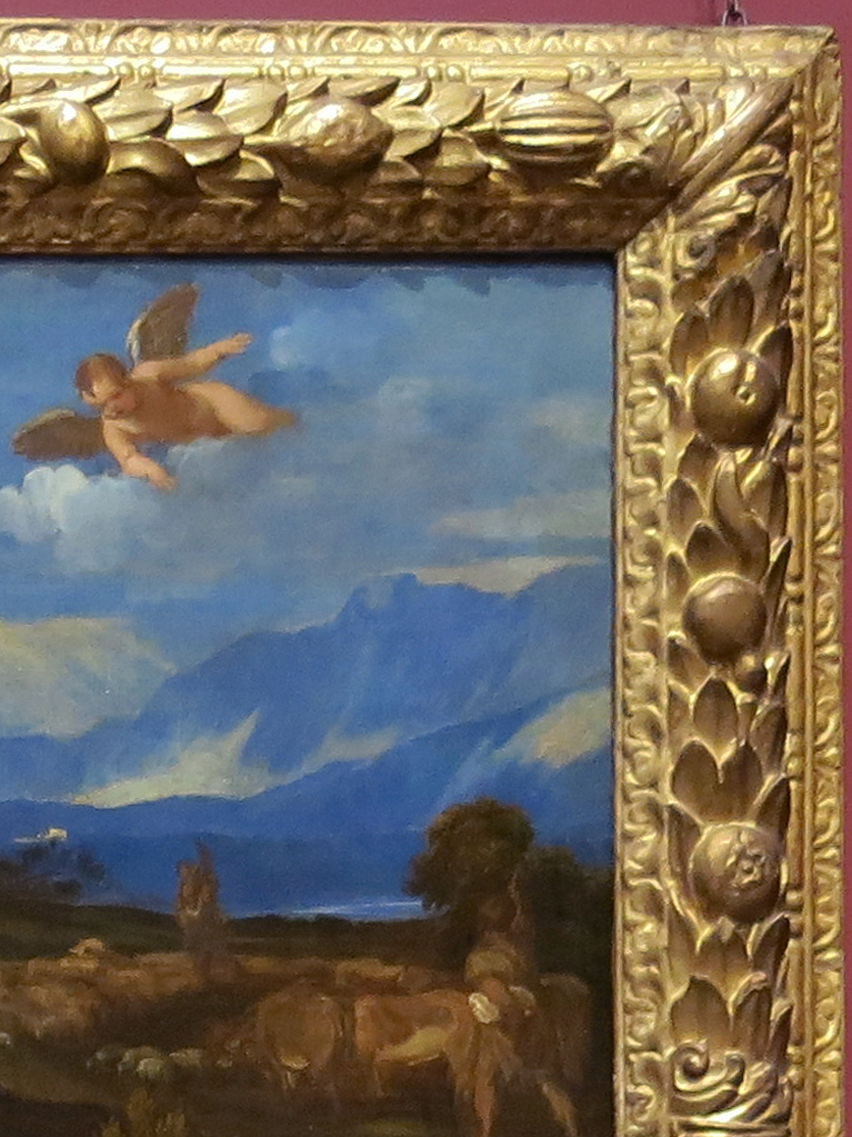
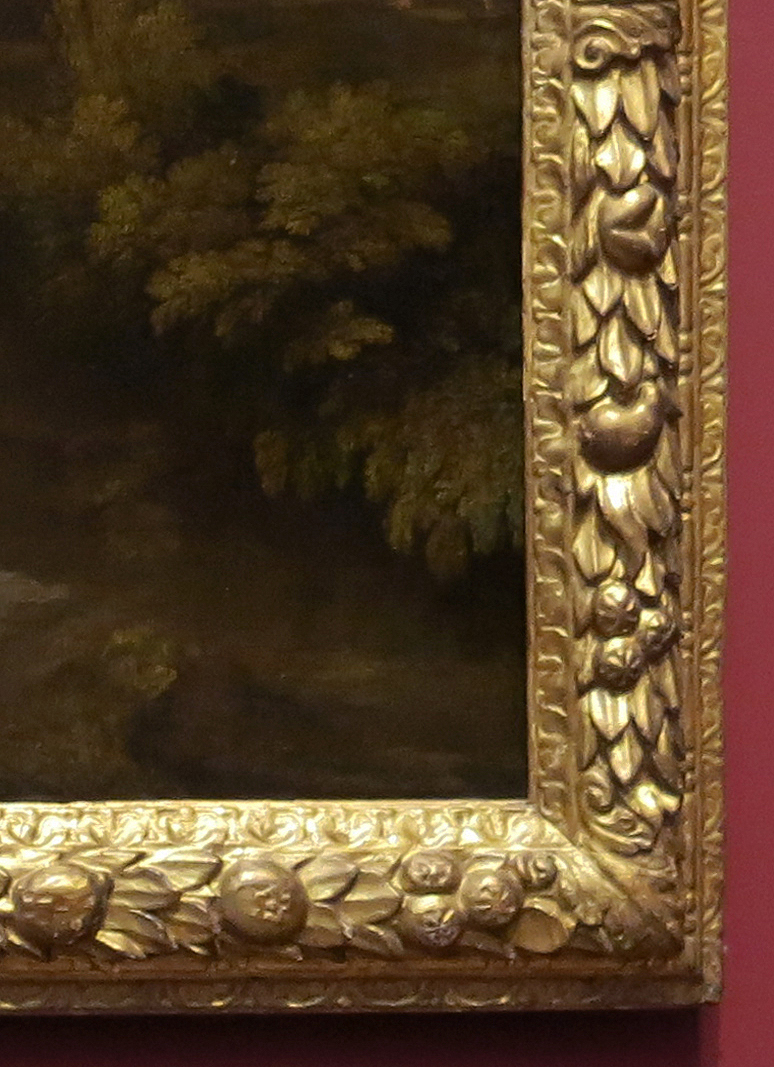
Titian fl. c.1506-d. 1576), Madonna & Child with John the Baptist & a saint (the ‘Aldobrandini Madonna’), c.1532, o/c, 100.6 x 142.2 c., in current frame, and details, National Gallery
In the light of so many symbolic fruit and flower frames, the decision to rehouse the National Gallery’s ‘Aldobrandini Madonna’ by Titian in a rectilinear torus frame of this kind was justified not only aesthetically, but by the composition of the garlands which fill almost the whole width of the rail. There are eight separate short garlands, which run from the acanthus leaf clasps in the centres out to the corners; they are composed of naturalistically-carved imbricated bay leaves, in which all the diverse fruits already mentioned are lurking – the gourd, pomegranate and quince for salvation and the Resurrection; the apple and orange for the Fall; the peach for Truth; the pear for Christ’s love; the lemon for the Virgin; nuts – either chestnuts for chastity and the Virgin, or hazelnuts for the Trinity. The unspecified event recorded in the painting, which seems to combine different elements of Christ’s early life, calls forth the remark in the Gallery’s description of the work as its being ‘a non-narrative picture intended for private devotion’, for which a frame full of symbols would provide the materials for contemplation and aids to prayer.
This language of fruit and flowers was obviously not confined to Italy, but was a European vernacular, diffused not only through the remains of Roman architecture scattered throughout the Empire, but through the medium of illuminated manuscripts and herbals. The frames of the great majority of French Renaissance sacred paintings may have vanished during the Revolution, but some of them have migrated: two, at least, finding homes on Italian Renaissance portraits.
Titian (fl. c.1506-d.1576), Gerolamo (?) Barbarigo, c.1510, o/c, 81.2 x 66.3 cm., National Gallery
Here, another Titian in the National Gallery collection has been set in a late Renaissance/ early Baroque version of a French Louis XIII garland frame (c.1600-50) [22]. It has a reverse profile, with a raised guilloche torus at the sight edge, and a wide frieze over which two branches of a grapevine climb from their ribbon-tied junction at the bottom centre to the top, where their leaves meet. The vine branch is gnarled and textured with bark-like striations, and the leaves are large, crumpled and undercut, giving a sculptural realism to the criss-crossing twigs and stems, and the luxuriant bunches of grapes. This frame could have been carved for a painting of the myth of Dionysos, god of wine, but is much more likely to refer to the Eucharist, and to have contained a Crucifixion or an image of Christ. United with a portrait, it becomes a decorative adjunct – an extremely beautiful one, but one in which the meaning and force of the motif is lost.
Raphael (1483-1520), Baldassare Castiglione, c.1514-15, o/c, 82 x 67 cm., Musée du Louvre
The other frame (second quarter of the 17th century) has been given to Raphael’s portrait of Baldassare Castiglione in the Louvre. The basic structure is the same, but the vine (now blossoming with a mixture of roses and other flowers, and thick with rose leaves) is much more tangled and intricate; it has presumably been made with four separate pieces, pierced and carved almost in the round, laid over the cross-hatched ground of the frieze. Where the vine on Titian’s frame is gently undulating, this is full of movement and animation. It contains roses (the attribute of the Virgin) on the bottom half of the left-hand side and the left side of the bottom rail; daisies (innocence and humility) in the corresponding top left sections; violets (the humility of Christ and the Virgin) and narcissi (divine love) on the right-hand side, and top and bottom rails. As with the grapevine frame, this arrangement might possibly have been made for a mythological subject – a painting of Flora, or a pastoral; the daisies may be sunflowers, the attribute of Apollo, the roses the flower of Venus, and the narcissi the personification of Narcissus.
Over time, the sacred language of flowers and fruit lapsed (except perhaps with lilies, which remained firmly connected with the Virgin). Flowers became the natural decoration for secular portraits of women – or the badge of scientific investigation for men. It was during the 19th century, that time of revivals of many periods and styles – in architecture, furniture, art and (of course) frames – that the symbolic garland frame also briefly reappeared.
Jean-Auguste-Dominique Ingres (1780-1867), La Vièrge adorant l’Hostie, 1854, o/c, 113 cm. diam., and detail, Musée d’Orsay
Ingres, who was particularly interested in marrying an appropriate frame to his paintings, used a rectilinear frame with a great wreath of mixed flowers and fruit around the frame of his 1854 painting, The Virgin adoring the Host, first executed in 1841 in a version with Russian saints for Alexander II of Russia, and now in the Pushkin Museum (sadly, not in a comparable frame). The tondo in the Musée d’Orsay (this seems to be the only round version, out of five or six in total) has spandrels with sprays of roses and lilies for the Virgin, whilst the garland on the outer torus contains more roses and lilies, daisies, pears, figs, quinces, ears of wheat, and almonds (signifying the Virgin’s purity). All of it would have been modelled in plaster, and would have involved an immense amount of work – almost comparable with carving it by hand; although the carved moulds would, of course, have been reusable.
Jean-Auguste-Dominique Ingres (1780-1867), Jeanne d ‘Arc au sacré de Charles VII, 1851-55, o/c, 240 x 178 cm., and detail, Musée du Louvre
In another instance, roughly contemporary with the Musée d’Orsay version of the Virgin adoring the Host, Ingres was commissioned by the Académie des Beaux-Arts d’Orléans to paint Joan of Arc at the coronation of Charles VII of France. With this frame, he returned to the genre of garland frame epitomized by the grapevine design now on Titian’s Gerolamo Barbarigo. It has a hollow profile in which separately-moulded sections of vine are laid, building up a complete undulating branch which fills each rail, symbolizing the Eucharist celebrated at the coronation mass.
Frederic, Lord Leighton (1830-96), The Garden of the Hesperides, 1891-92, o/c, 66 ½ ins diam. (169 cm.), and detail, Lady Lever Art Gallery, Port Sunlight
In Victorian Protestant England, the garland frame revisted its classical roots with Lord Leighton’s large tondo of the Garden of the Heperides. The Hesperides lie under the tree where the Golden Fleece hangs, guarded by the serpent Ladon; it has become an orange tree, rather than a tree with the golden apples of the myth, by a retrospective conflation of a fruit which came west from China in the Middle Ages, and the supposed location of the garden in southern Spain or Libya. Leighton’s frame therefore contains a great ribbon-bound torus modelled on the Renaissance tondo garland, with a wreath of oranges, orange leaves and flowers. It turns inside out Ingres’s design for the Virgin and the Host, with the garland at the sight edge and the spandrels on the outside [23] – although Leighton also produced a garland frame for his tondo, Acme & Septimius, after Ingres’s pattern. Neither uses the fruit and flowers for their symbolical meaning; perhaps, however, Leighton is returning to the NeoPlatonic garden of the Hypnerotomachia Poliphili, in which a beautiful and retired classical Eden is a place of virtue, moral worth – and love.
Frederic, Lord Leighton (1830-96), Acme & Septimius, pre-1868, o/c, 99 cm. diam., Ashmolean Museum
If so, there is an undercurrent of unease; the Garden of the Hesperides is a place of peace and harmony, but is invaded by adventurers who want to steal the golden fruit in the garland; Acme and Septimius are on such a purple plane of emotion that disappointment must lurk, like wasps in the various fruit which surround them. And, like Leighton’s design for The Garden of the Hesperides, and although it is gilded like an Italian tondo frame, the setting of Acme and Septimius hearkens back to the garlands and festoons on classical buildings and sarcophagi, bringing the sweep of the genre full circle.
These were just late, decorative flourishes of an earlier style, however; it was the Renaissance which gave the garland frame a whole vocabulary. At a time and in a place where society was dependent on a widespread knowledge of plants far more immediate and practical than is true today, the symbolic meanings would naturally follow in the wake of the culinary and medicinal, and would be presented to worshippers in some form whenever they entered a church, and frequently in the world outside. The flowers, fruit and foliage which were chosen to ornament frames were beautiful decorations, but they also provided what would have been instantly recognizable glyphs, easily translatable by the reading and non-reading population alike, and combining into strings of meanings, which – like captions on a modern illustration, or on a single ‘frame’ in a comic book – explained or commented upon the painted image.
Andrea della Robbia (1435-1525), Marriage of St Joseph & the Virgin, Malmø Konstmuseum. Photo: Gunnar Bach Pedersen
*******************************
This article is indebted to James Hall’s Dictionary of subjects & symbols in art, 1974, 1996 ed.; and to Doug Gray, Christian symbology, 2001-20
*******************************
[1] The calla or arum lilies on the bottom of this frame were only introduced to Europe in the 17th century
[2] See ‘National Gallery, London: reframing Mantegna’
[3] Jutta Dresken-Weiland, ‘Christian sarcophagi from Rome’, The Routledge handbook of early Christian art, 2018
[4] See ‘Strigillated frames: the ripples of Mannerism’
[5] Elizabeth R. Schaeffer, Image and meaning in the floral borders of ‘The Hours of Catherine of Cleves’, 1987, Master’s thesis, Eastern Illinois University, abstract
[6] Ibid., p. 21
[7] Giles Laval, ‘Say it with flowers: An introduction to floral symbolism in manuscript illumination’
[8] Ibid.
[9] Ibid.
[10] Schaeffer, op. cit., p. 33
[11] See Christina Alphonso, ‘Cobb nuts, Christmastide, and The Cloisters’
[12] The Project Gutenberg EBook of Hypnerotomachia, by Francesco Colonna, translated by Robert Dallington, London, 1592
[13] Ibid.
[14] The Latin words for apple and evil are fortuitously the same (‘malum’), so St Jerome used ‘apple’ for the Hebrew ‘fruit’ in his translation of the Bible, the Latin Vulgate, linking apples and the Fall forever in the minds of Western Europeans. However, apples are rare fruit in Mesopotamia, the supposed location of the Garden of Eden, and many other more likely candidates have been suggested, including (as well as quinces and oranges) figs, apricots and pomegranates
[15] Schaeffer, op. cit., p. 35, ff.
[16] Timothy Newbery, George Bisacca & Laurence Kanter, Italian Renaissance frames, exh. cat., Metropolitan Museum of Art, 1990, p. 82
[17] Old testament, ‘Song of songs: which is Solomon’s’, 4:12: ‘A garden inclosed is my sister, my spouse; a garden inclosed, a fountain sealed up’
[18] Christadelphian Books Online
[19] For bindweed, see Schaeffer, op. cit., p. 43
[20] The first frame of this Bellini in the Gallery was a 19th century British altarpiece frame; you can read more about the reframing here
[21] Harold N. Moldenke, ‘Flowers of the Madonna’, Plants of the Bible: Horticulture, December, 1953. This article provides a detailed description and interpretation of all the flowers associated with the Virgin
[22] This frame was sold (probably out of the Orléans Collection) after the French Revolution, and was one of the exhibits in Serge Roche’s pioneering exhibition of frames in 1931, at the Galerie Georges Petit in Paris
[23] The shells set in triangular inserts in the spandrels, on a wave-like textured ground, probably refer to the spring struck out of the ground in the garden by Heracles, when he visited it to steal some of the apples; the Argonauts were later to drink from the same spring. They may also refer to the Argo, and Jason’s voyage to the Hesperides







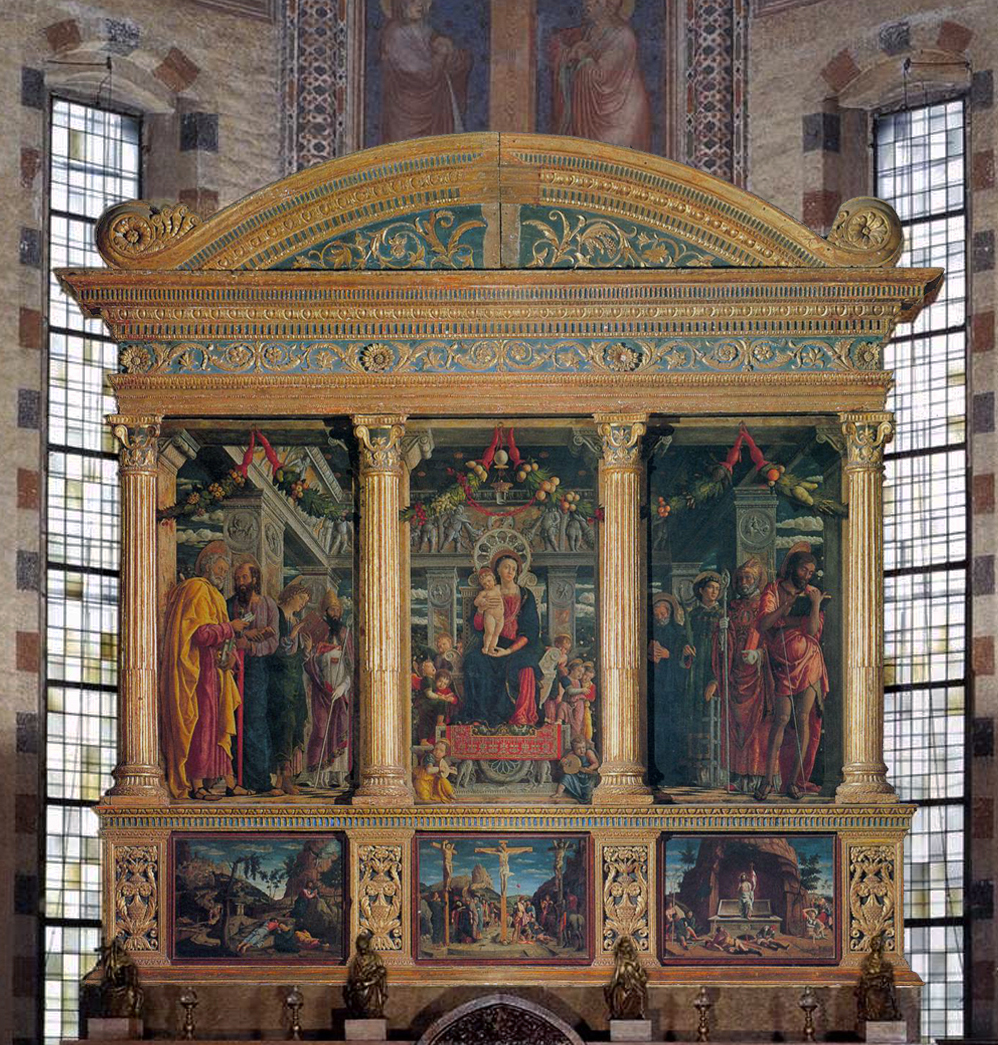



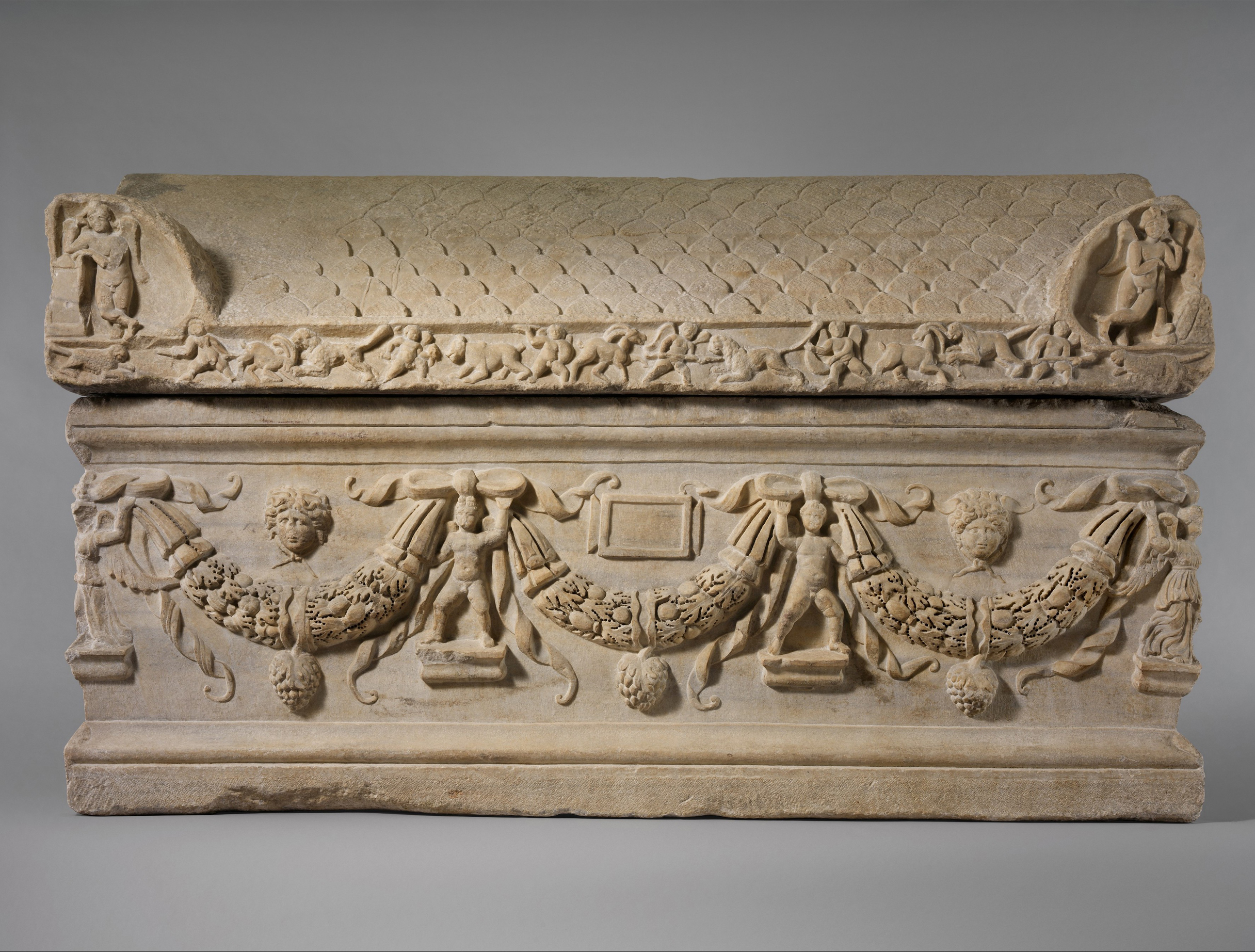


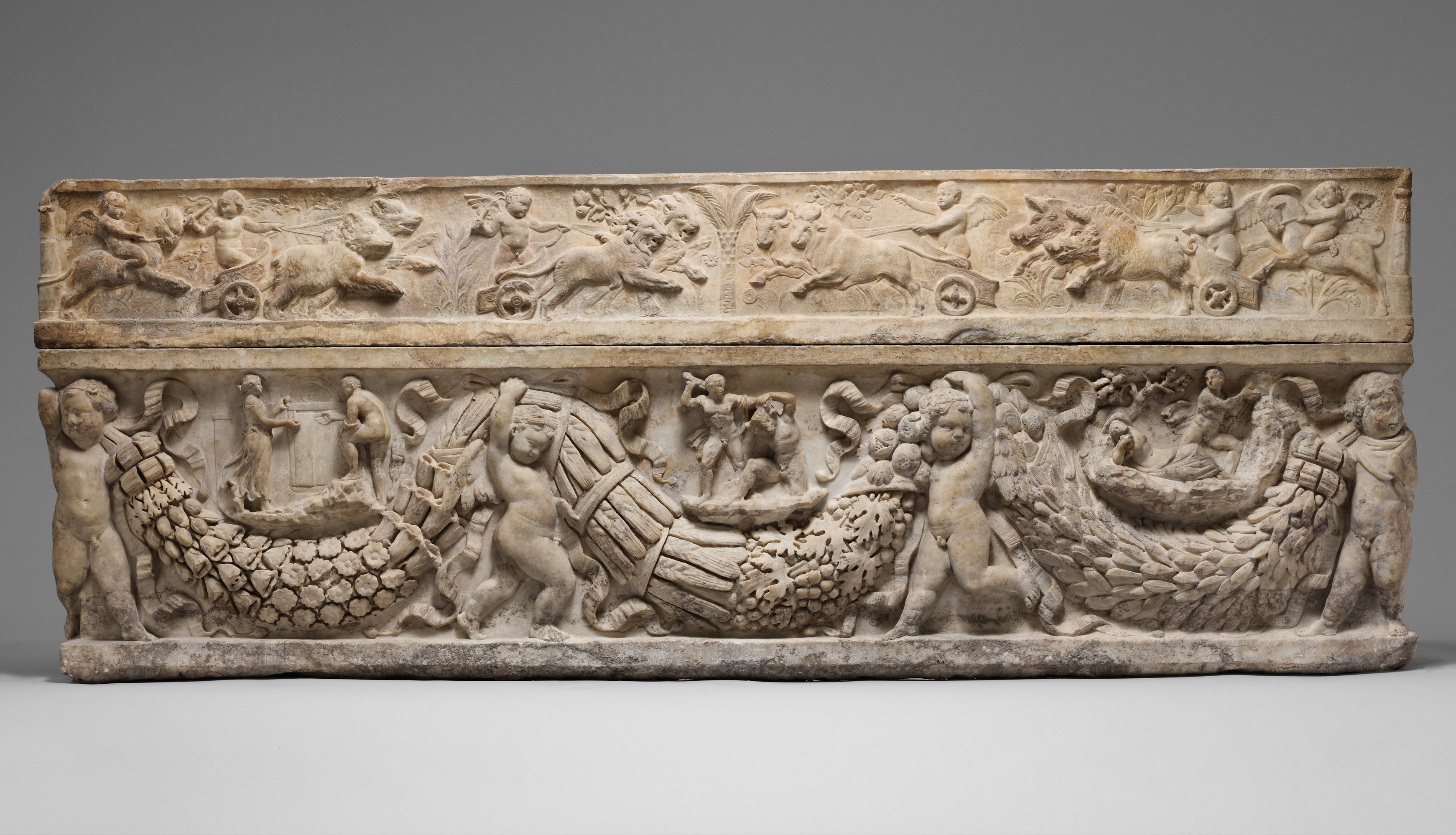
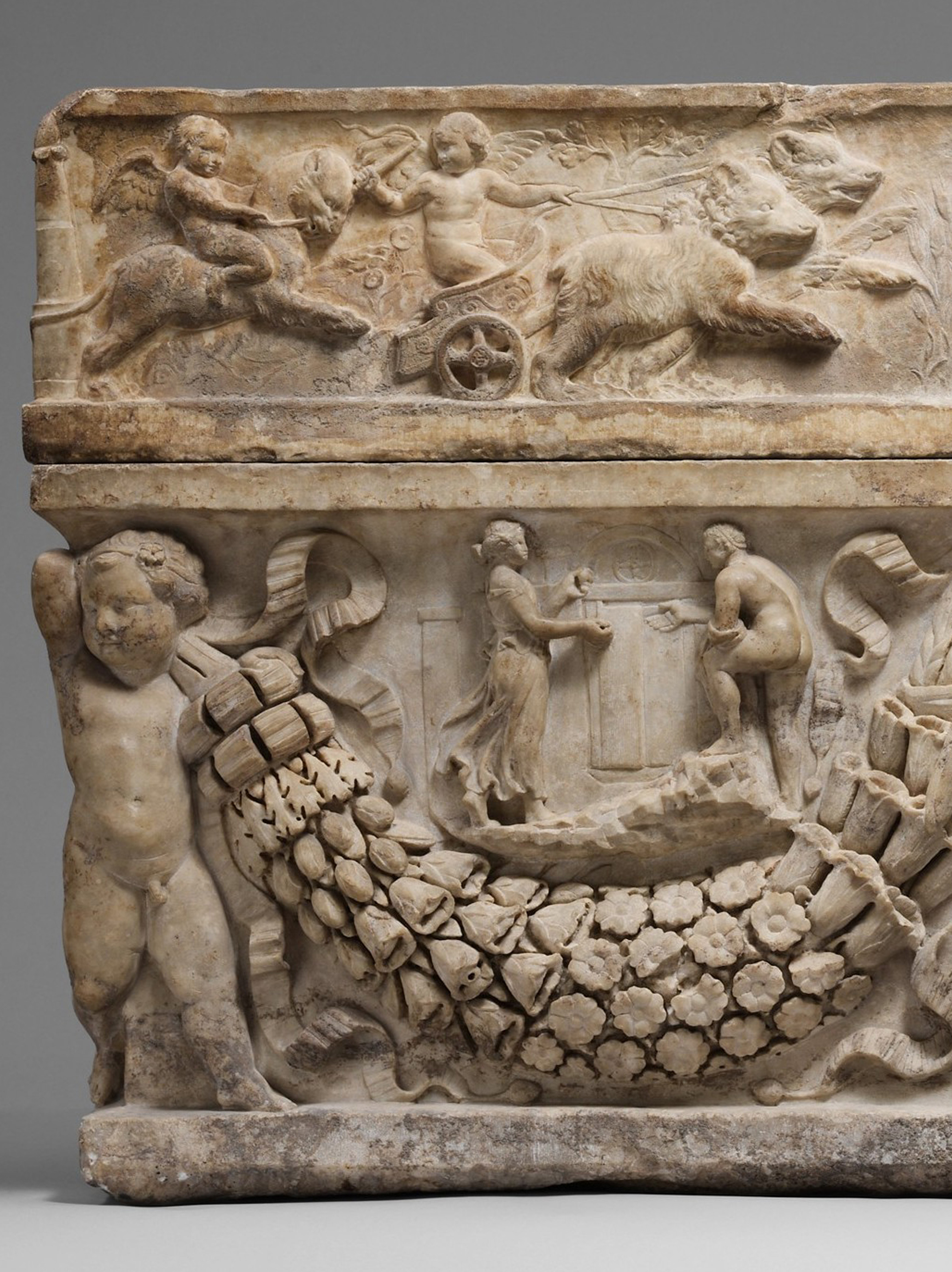




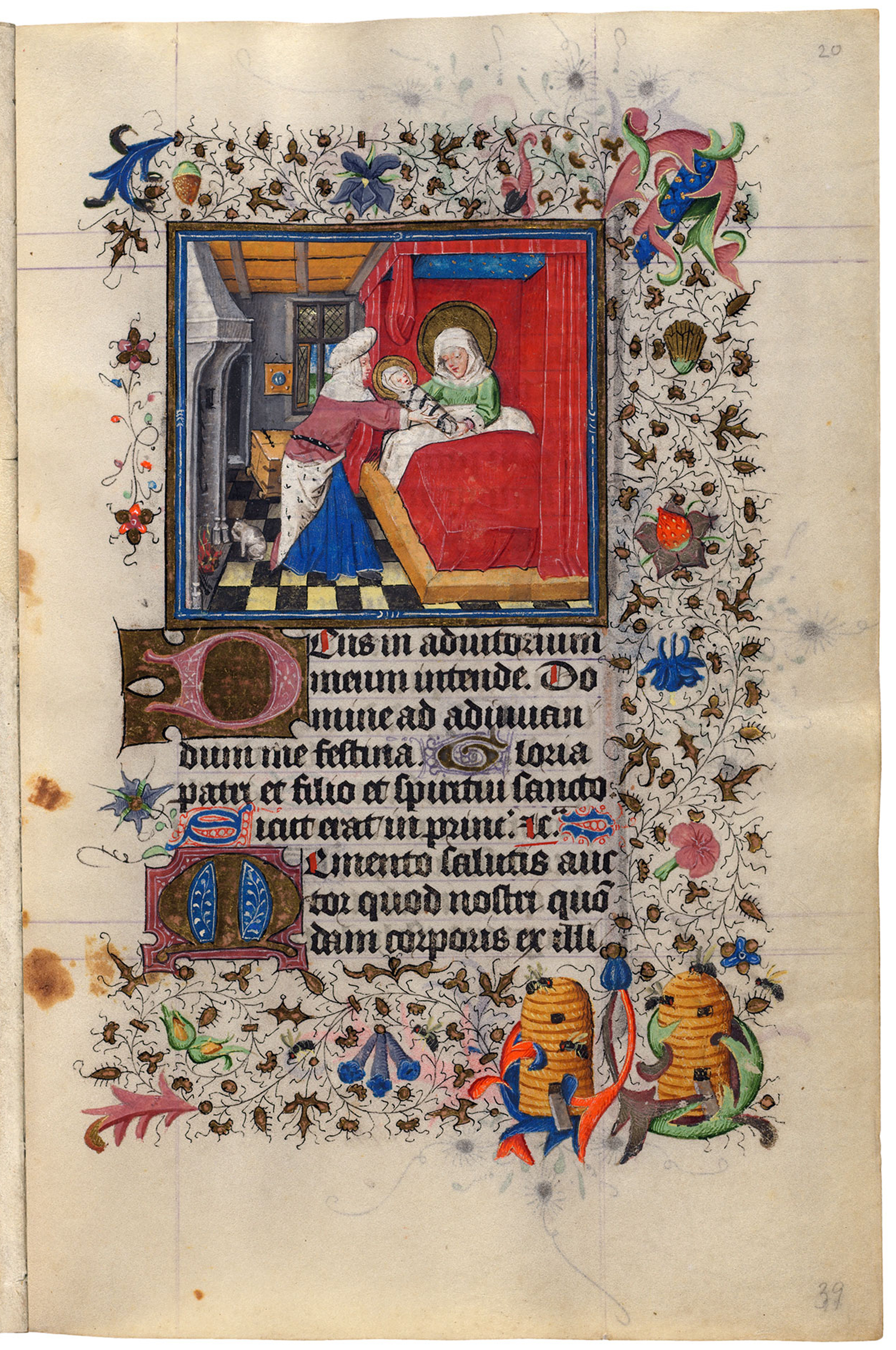
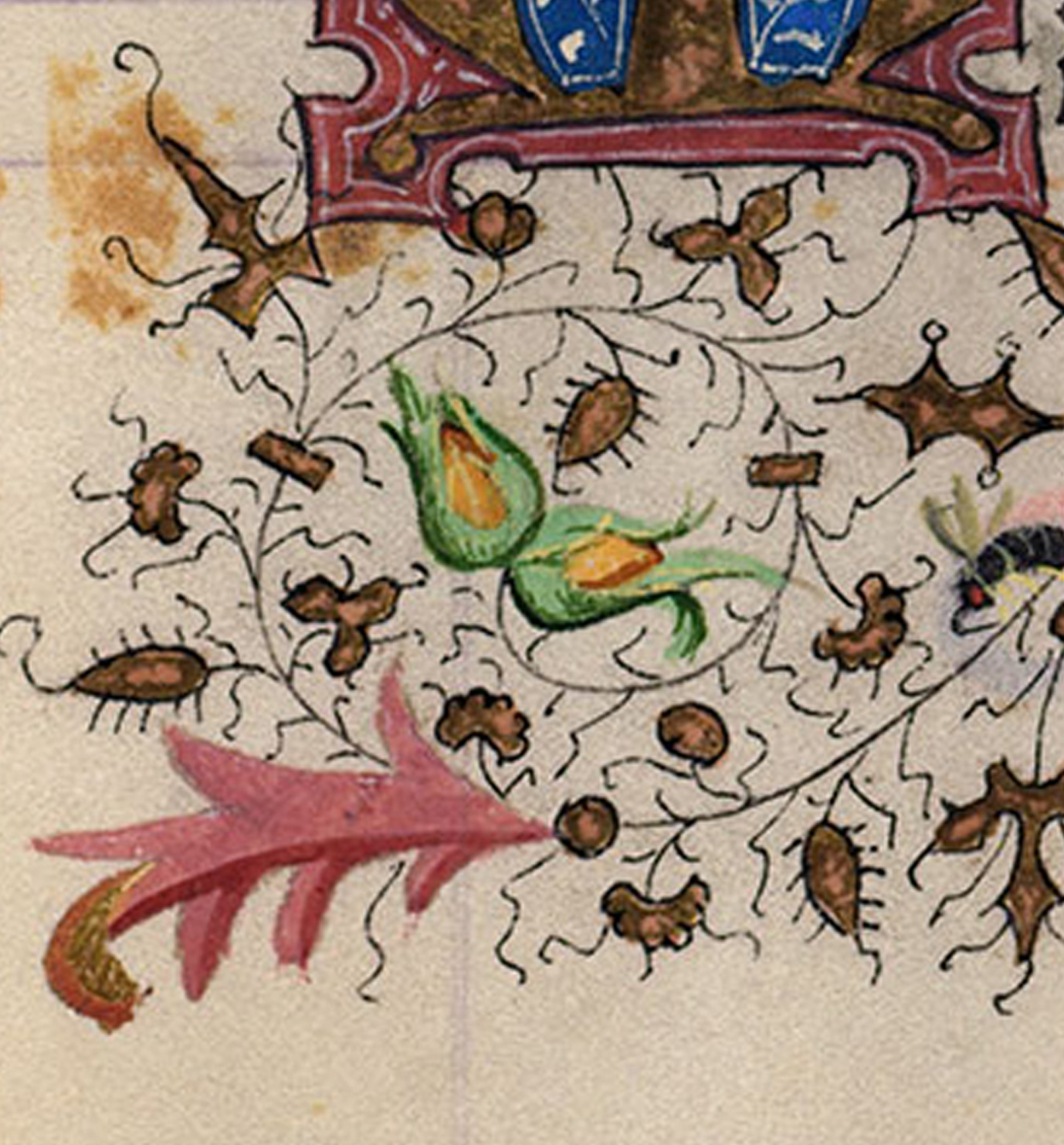









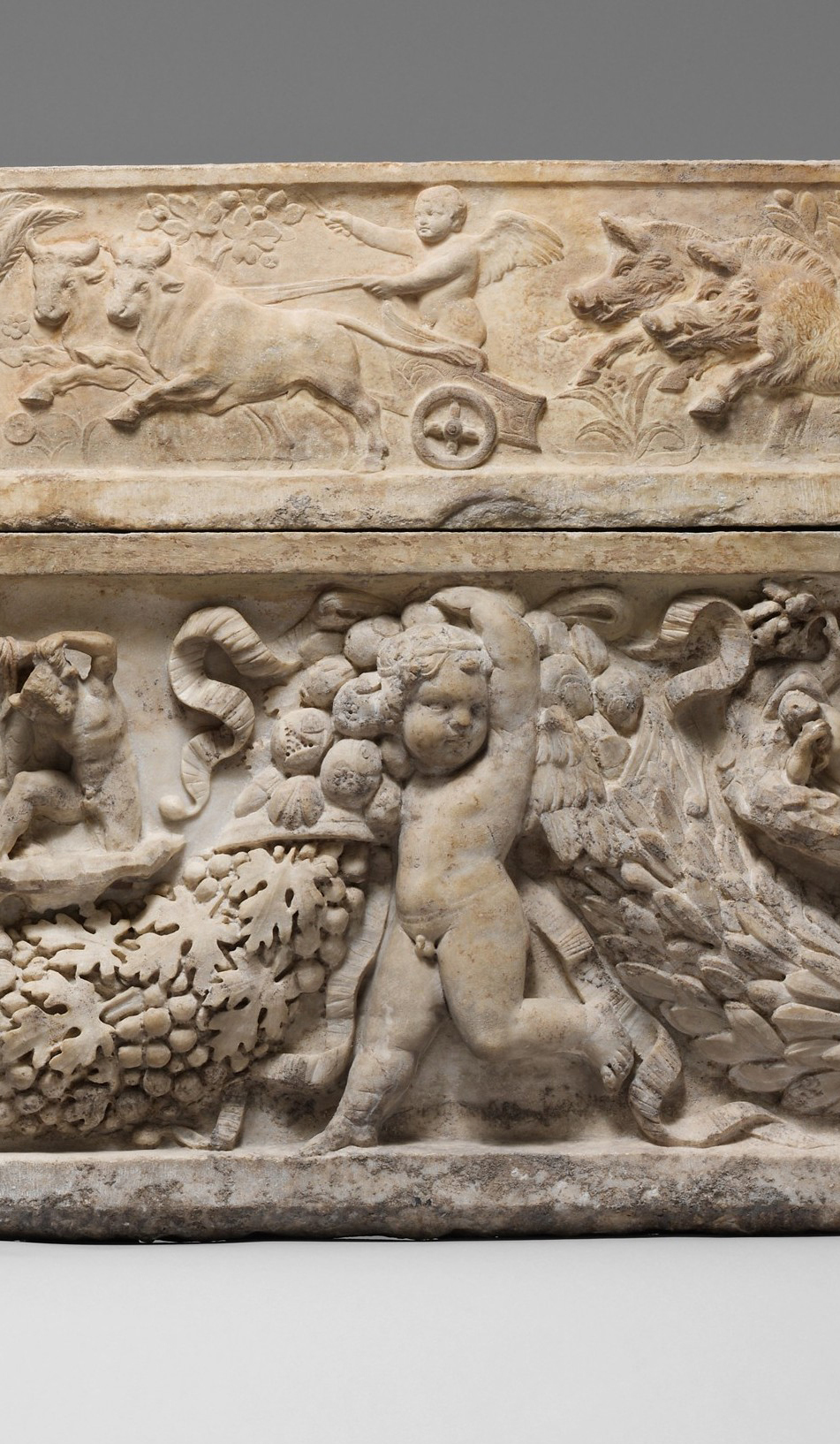









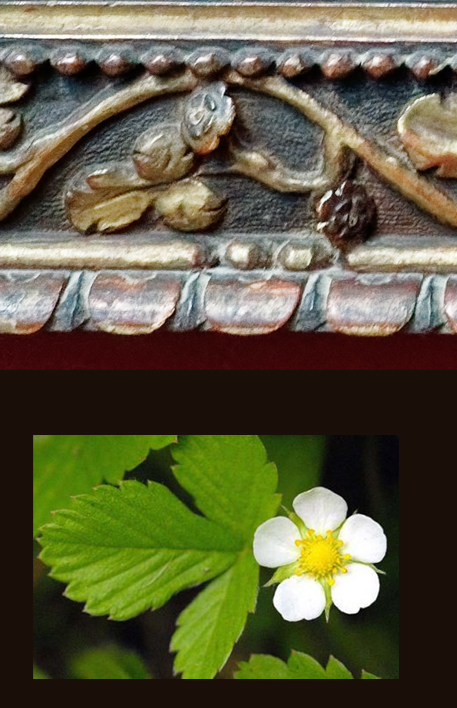


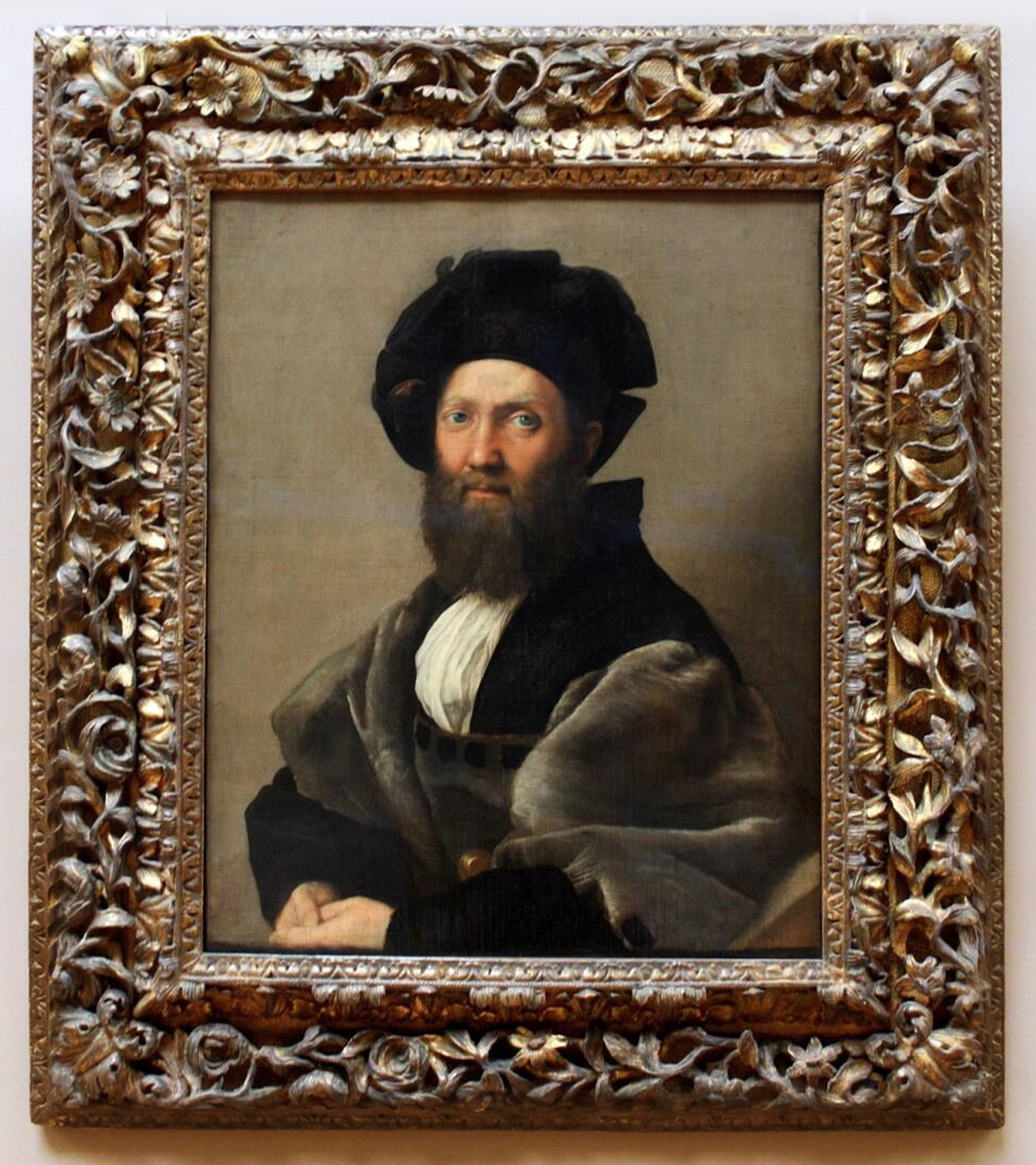
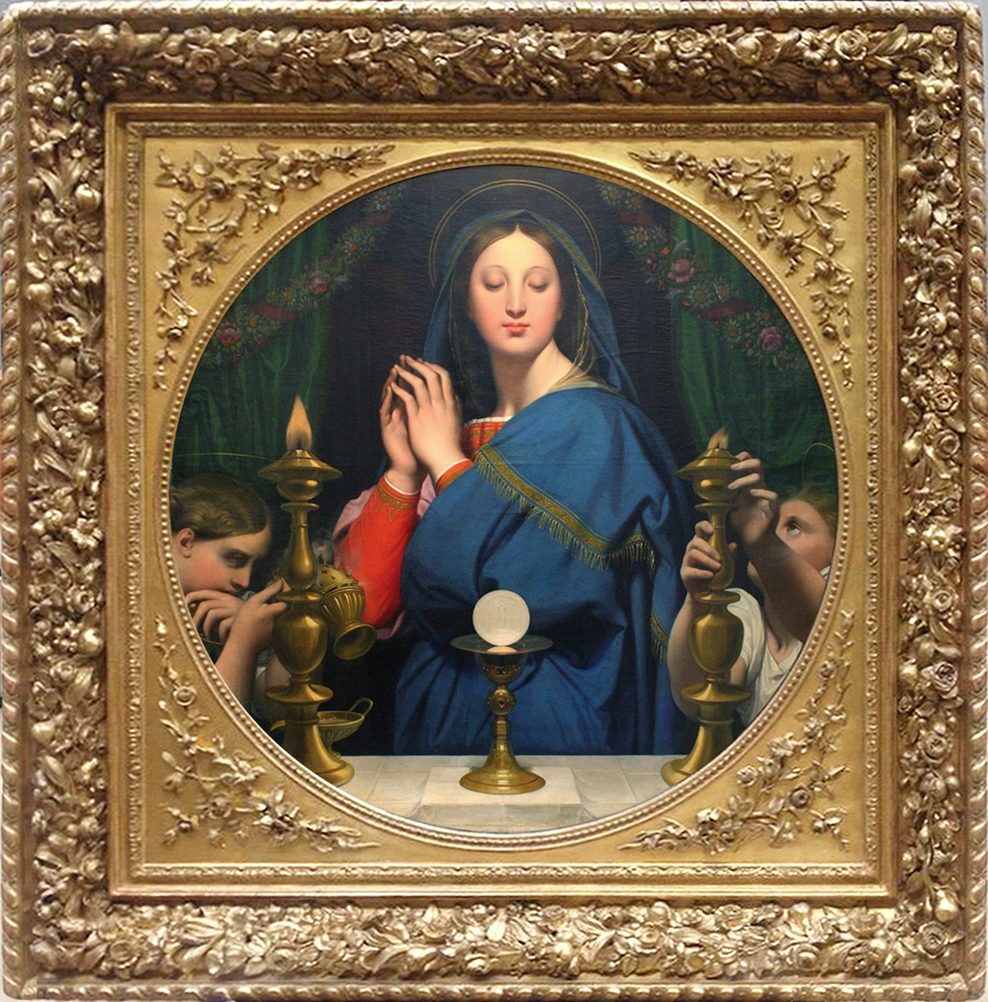

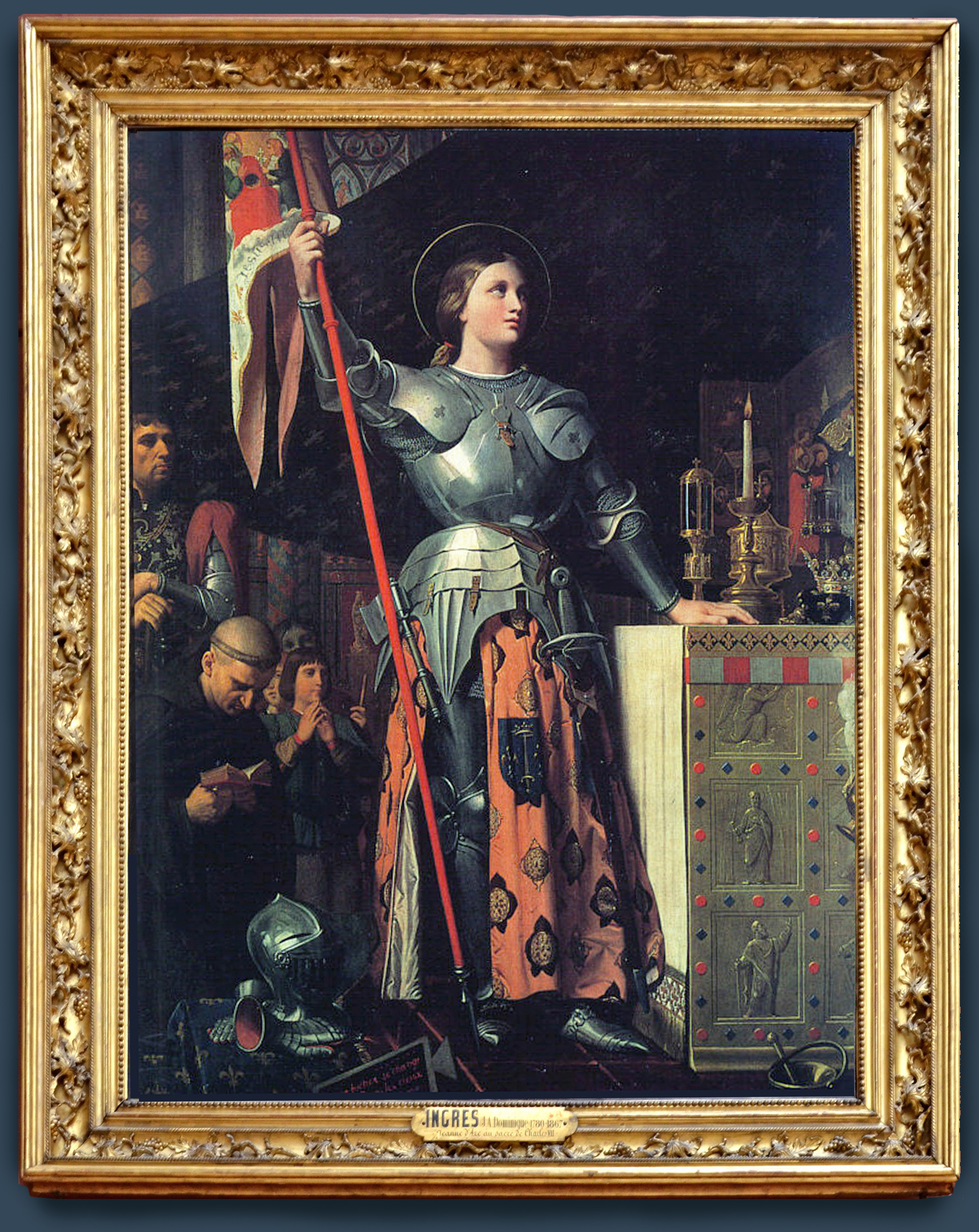


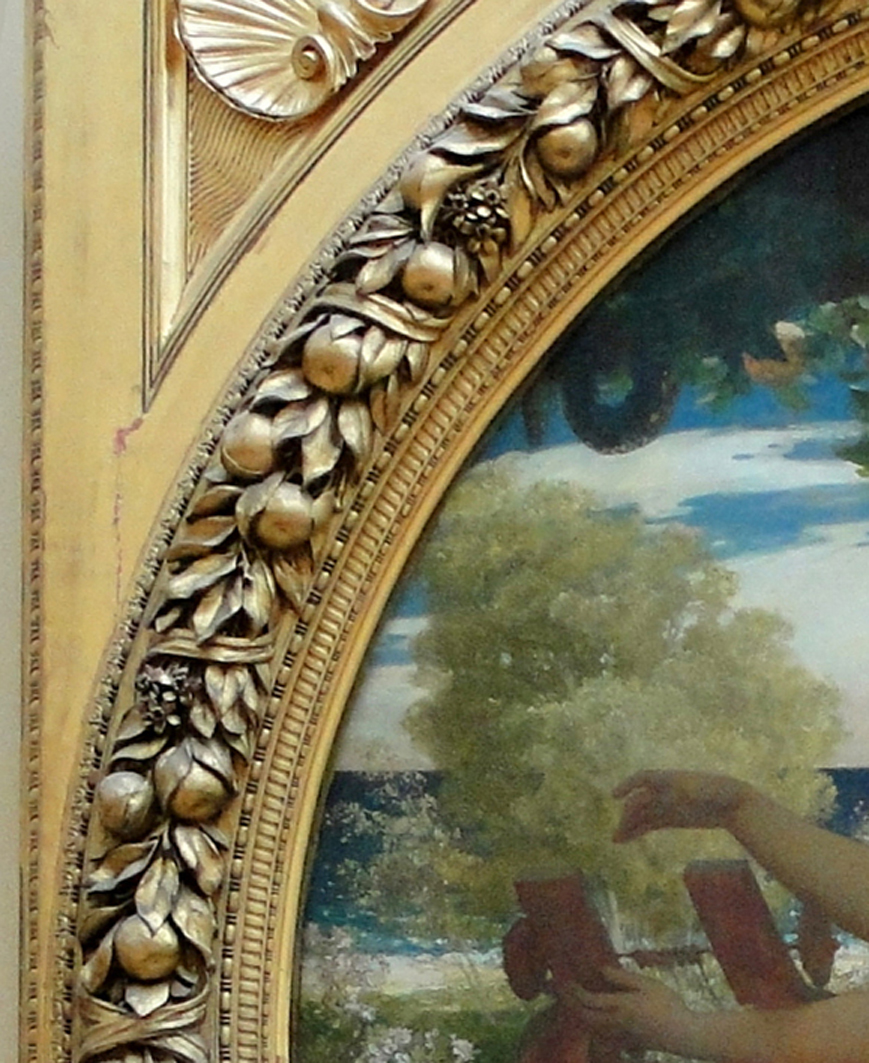


[…] This compilation starts with the 12th century, and a ‘framed’ tondo in fresco which was cut with its pendant from the interior of the church of San Nicola in Carcere, Rome. San Nicola was an early church, first constructed in the 6th century from Roman spolia and formally dedicated in 1128 – around the date of the fresco. It reveals that already, at this early period, the garland frame full of symbolic fruits was in use for sacred subjects, filched from the wreaths and festoons on classical sarcophagi or mosaic roundels, but interpreting each fruit with meanings applicable to the Christian era (for more on this subject, see ‘Fruit, flowers, foliage: the symbolism of Renaissance frames’). […]
LikeLike
[…] more on garland frames, see ‘Fruit, flowers, foliage: the symbolism of Renaissance frames’, and ‘The tondo frame in Renaissance Florence: a […]
LikeLike
[…] In the last decade of the Quattrocento, a type of frame emerges which is closely connected to the fruit and floral garland frames of glazed terracotta tondi by the Della Robbia family [see more on the history and symbolism of garland frames in ‘Fruit, flowers, foliage: the symbolism of Renaissance frames’]. […]
LikeLike
Marvelous information and resource, as always.
LikeLike
Thank you! – you are very kind, and I’m extremely glad if you found it of interest…
LikeLike
magnifique, I love your newsletter
LikeLike
How nice of you! – thank you so much… 🙂
LikeLike